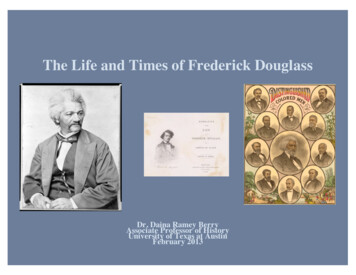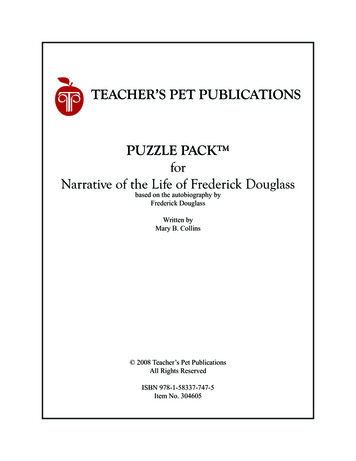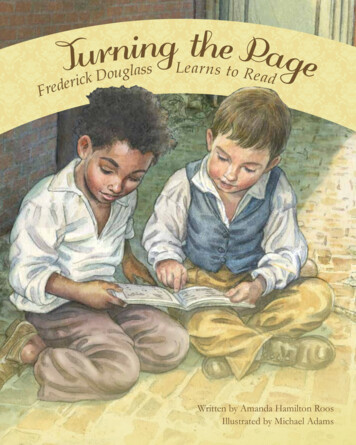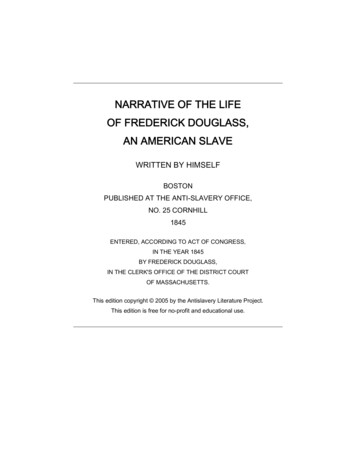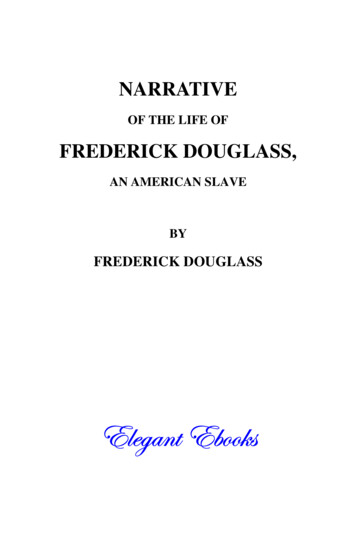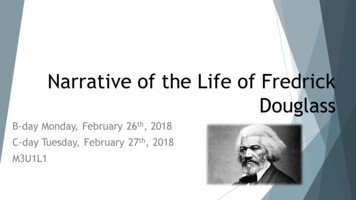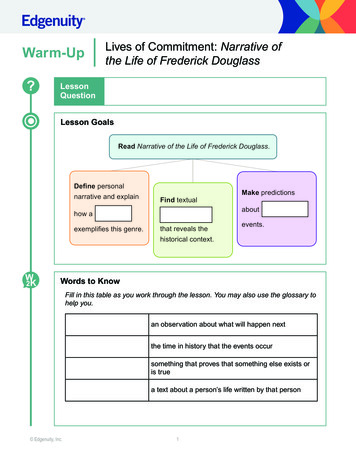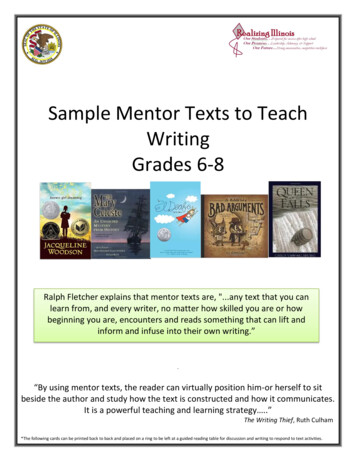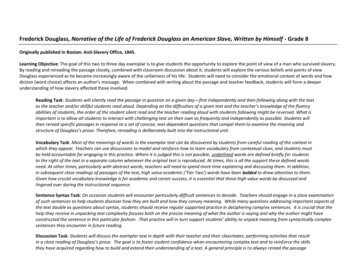
Transcription
Frederick Douglass, Narrative of the Life of Frederick Douglass an American Slave, Written by Himself - Grade 8Originally published in Boston: Anti-Slavery Office, 1845.Learning Objective: The goal of this two to three day exemplar is to give students the opportunity to explore the point of view of a man who survived slavery.By reading and rereading the passage closely, combined with classroom discussion about it, students will explore the various beliefs and points of viewDouglass experienced as he became increasingly aware of the unfairness of his life. Students will need to consider the emotional context of words and howdiction (word choice) affects an author’s message. When combined with writing about the passage and teacher feedback, students will form a deeperunderstanding of how slavery affected those involved.Reading Task: Students will silently read the passage in question on a given day—first independently and then following along with the textas the teacher and/or skillful students read aloud. Depending on the difficulties of a given text and the teacher’s knowledge of the fluencyabilities of students, the order of the student silent read and the teacher reading aloud with students following might be reversed. What isimportant is to allow all students to interact with challenging text on their own as frequently and independently as possible. Students willthen reread specific passages in response to a set of concise, text-dependent questions that compel them to examine the meaning andstructure of Douglass’s prose. Therefore, rereading is deliberately built into the instructional unit.Vocabulary Task: Most of the meanings of words in the exemplar text can be discovered by students from careful reading of the context inwhich they appear. Teachers can use discussions to model and reinforce how to learn vocabulary from contextual clues, and students mustbe held accountable for engaging in this practice. Where it is judged this is not possible, underlined words are defined briefly for studentsto the right of the text in a separate column whenever the original text is reproduced. At times, this is all the support these defined wordsneed. At other times, particularly with abstract words, teachers will need to spend more time explaining and discussing them. In addition,in subsequent close readings of passages of the text, high value academic (‘Tier Two’) words have been bolded to draw attention to them.Given how crucial vocabulary knowledge is for academic and career success, it is essential that these high value words be discussed andlingered over during the instructional sequence.Sentence Syntax Task: On occasion students will encounter particularly difficult sentences to decode. Teachers should engage in a close examinationof such sentences to help students discover how they are built and how they convey meaning. While many questions addressing important aspects ofthe text double as questions about syntax, students should receive regular supported practice in deciphering complex sentences. It is crucial that thehelp they receive in unpacking text complexity focuses both on the precise meaning of what the author is saying and why the author might haveconstructed the sentence in this particular fashion. That practice will in turn support students’ ability to unpack meaning from syntactically complexsentences they encounter in future reading.Discussion Task: Students will discuss the exemplar text in depth with their teacher and their classmates, performing activities that resultin a close reading of Douglass’s prose. The goal is to foster student confidence when encountering complex text and to reinforce the skillsthey have acquired regarding how to build and extend their understanding of a text. A general principle is to always reread the passage
that provides evidence for the question under discussion. This gives students another encounter with the text, helping them developfluency and reinforcing their use of text evidence.Writing Task: Students will write an explanatory paragraph using their understanding of the word choice and emotions expressed in theselection to present their opinions about what Douglass is trying to explain to the audience. Teachers might afford students theopportunity to revise their paragraphs after participating in classroom discussion or receiving teacher feedback, allowing them torefashion both their understanding of the text and their expression of that understanding.Outline of Lesson Plan: This lesson can be delivered in two to three days of instruction and reflection on the part of students and their teacher.Standards Addressed: The following Common Core State Standards are the focus of this exemplar: RL 8.1, RL.8.2, RL.8.3, RL.8.4; W.8.1, W.8.4; SL.8.1, SL.8.3.
The Text: Douglass, Frederick. Narrative of the Life of Frederick Douglass an American Slave, Written by Himself (1845)Exemplar TextThe plan which I adopted, and the one by which I was most successful, was that ofmaking friends of all the little white boys whom I met in the street. As many of these as Icould, I converted into teachers. With their kindly aid, obtained at different times and indifferent places, I finally succeeded in learning to read. When I was sent on errands, Ialways took my book with me, and by going on one part of my errand quickly, I foundtime to get a lesson before my return. I used also to carry bread with me, enough ofwhich was always in the house, and to which I was always welcome; for I was muchbetter off in this regard than many of the poor white children in our neighborhood. Thisbread I used to bestow upon the hungry little urchins, who, in return, would give methat more valuable bread of knowledge. I am strongly tempted to give the names oftwo or three of those little boys, as a testimonial of the gratitude and affection I bearthem; but prudence forbids;—not that it would injure me, but it might embarrass them;for it is almost an unpardonable offence to teach slaves to read in this Christiancountry. It is enough to say of the dear little fellows, that they lived on Philpot Street,very near Durgin and Bailey’s ship-yard. I used to talk this matter of slavery over withthem. I would sometimes say to them, I wished I could be as free as they would bewhen they got to be men. “You will be free as soon as you are twenty-one, but I am aslave for life! Have not I as good a right to be free as you have?” These words used totrouble them; they would express for me the liveliest sympathy, and console me withthe hope that something would occur by which I might be free.I was now about twelve years old, and the thought of being a slave for life began tobear heavily upon my heart. Just about this time, I got hold of a book entitled “TheColumbian Orator.” Every opportunity I got, I used to read this book. Among much ofother interesting matter, I found in it a dialogue between a master and his slave. Theslave was represented as having run away from his master three times. The dialoguerepresented the conversation which took place between them, when the slave wasretaken the third time. In this dialogue, the whole argument in behalf of slavery wasbrought forward by the master, all of which was disposed of by the slave. The slave wasmade to say some very smart as well as impressive things in reply to his master—thingswhich had the desired though unexpected effect; for the conversation resulted in thevoluntary emancipation of the slave on the part of the master.Vocabularychore (singular)giveto show ofthankfulness;state of being wiseand carefulplace where shipsare repaired orbuiltspeakerthrown outrelease
In the same book, I met with one of Sheridan’s mighty speeches on and in behalf ofCatholic emancipation. These were choice documents to me. I read them over and overagain with unabated interest. They gave tongue to interesting thoughts of my own soul,which had frequently flashed through my mind, and died away for want of utterance.The moral which I gained from the dialogue was the power of truth over the conscienceof even a slaveholder. What I got from Sheridan was a bold denunciation of slavery, anda powerful vindication of human rights. The reading of these documents enabled me toutter my thoughts, and to meet the arguments brought forward to sustain slavery; butwhile they relieved me of one difficulty, they brought on another even more painfulthan the one of which I was relieved. The more I read, the more I was led to abhor anddetest my enslavers. I could regard them in no other light than a band of successfulrobbers, who had left their homes, and gone to Africa, and stolen us from our homes,and in a strange land reduced us to slavery. I loathed them as being the meanest as wellas the most wicked of men. As I read and contemplated the subject, behold! that verydiscontentment which Master Hugh had predicted would follow my learning to readhad already come, to torment and sting my soul to unutterable anguish. As I writhedunder it, I would at times feel that learning to read had been a curse rather than ablessing. It had given me a view of my wretched condition, without the remedy. Itopened my eyes to the horrible pit, but to no ladder upon which to get out. In momentsof agony, I envied my fellow-slaves for their stupidity. I have often wished myself abeast. I preferred the condition of the meanest reptile to my own. Any thing, no matterwhat, to get rid of thinking! It was this everlasting thinking of my condition thattormented me. There was no getting rid of it. It was pressed upon me by every objectwithin sight or hearing, animate or inanimate. The silver trump of freedom had rousedmy soul to eternal wakefulness. Freedom now appeared, to disappear no more forever.It was heard in every sound, and seen in every thing. It was ever present to torment mewith a sense of my wretched condition. I saw nothing without seeing it, I heard nothingwithout hearing it, and felt nothing without feeling it. It looked from every star, it smiledin every calm, breathed in every wind, and moved in every storm.a movement toallow Catholics tohave full rights;speaking out loudpublicly condemnkeep alivehatesquirmed orstruggledmiserablealive; resource oradvantage moreimportant thanany other (shortfor trumpet)
Day One: Instructional Exemplar for Douglass’ Narrative of the Life of Frederick Douglass an American SlaveSummary of Activities1. Teacher introduces the day’s passage with minimal commentary and students read it independently. (5 minutes)2. Teacher or a skillful reader then reads the passage out loud to the class as students follow along in the text. (5 minutes)3. Teacher asks the class to discuss the first set of text-dependent questions and perform targeted tasks about the passage, with answers in theform of notes, annotations to the text, or more formal responses as appropriate. (40 minutes)4. Teacher then assigns a paragraph that asks students to write an analysis of Douglass’ text.Text Passage under DiscussionThe plan which I adopted, and the one by which I wasmost successful, was that of making friends of all thelittle white boys whom I met in the street. As many ofthese as I could, I converted into teachers. With theirkindly aid, obtained at different times and in differentplaces, I finally succeeded in learning to read . . .[read the intervening text]. . . The slave was made to say some very smart as wellas impressive things in reply to his master—things whichhad the desired though unexpected effect; for theconversation resulted in the voluntary emancipation ofthe slave on the part of the master.Directions for Teachers/Guiding Questions For Students1. Introduce the passage and students read independently.Other than giving the brief definitions offered to words students wouldlikely not be able to define from context (underlined in the text), avoidgiving any background context or instructional guidance at the outset ofthe lesson while students are reading the text silently. This close readingapproach forces students to rely exclusively on the text instead ofprivileging background knowledge and levels the playing field for allstudents as they seek to comprehend Douglass’s prose. It is critical tocultivating independence and creating a culture of close reading thatstudents initially grapple with rich texts like Douglass’ text without the aidof prefatory material, extensive notes, or even teacher explanations.2. Read the passage out loud to the class as students follow along in the text.Asking students to listen to Narrative of the Life exposes them a secondtime to the rhythms and meaning of Douglass’ language before they begintheir own close reading of the passage. Speaking clearly and carefully willallow students to follow Douglass’ narrative, and reading out loud withstudents following along improves fluency while offering all studentsaccess to this complex text. Accurate and skillful modeling of the readingprovides students who may be dysfluent with accurate pronunciations andsyntactic patterns of English.
Text Under DiscussionThe plan which I adopted, and the one bywhich I was most successful, was that ofmaking friends of all the little white boyswhom I met in the street. As many of theseas I could, I converted into teachers. Withtheir kindly aid, obtained at different timesand in different places, I finally succeededin learning to read. When I was sent onerrands, I always took my book with me,and by going on one part of my errandquickly, I found time to get a lesson beforemy return. I used also to carry bread withme, enough of which was always in thehouse, and to which I was always welcome;for I was much better off in this regard thanmany of the poor white children in ourneighborhood. This bread I used to bestowupon the hungry little urchins, who, inreturn, would give me that more valuablebread of knowledge. I am strongly temptedto give the names of two or three of thoselittle boys, as a testimonial of the gratitudeand affection I bear them; but prudenceforbids;—not that it would injure me, but itmight embarrass them; for it is almost anunpardonable offence to teach slaves toread in this Christian country. It is enoughto say of the dear little fellows, that theylived on Philpot Street, very near Durginand Bailey’s ship-yard.Directions for Teachers/Guiding Questions For Students3. Ask the class to answer a small set of text-dependent guided questionsand perform targeted tasks about the passage, with answers in the form ofnotes, annotations to the text, or more formal responses as appropriate.As students move through these questions and reread Douglass’ text, besure to check for and reinforce their understanding of academic vocabularyin the corresponding text (which will be boldfaced the first time it appearsin the text). At times, the questions themselves may focus on academicvocabulary.choregiveto showthankfulness;state of beingwise andcarefulplace whereships arerepaired orbuilt(Q1) Why is Douglass specific about making friends with “little white boys”?Students may not have internalized the title and may not understand thatthis is a story of a former slave or that this is during the period wherewhites had a lot more power. Teachers should point them back to the titleif they cannot answer this question, allowing students to clarify their ownthinking through the text.(Q2) How did Douglass learn how to read when running errands?Taking bread with him, he would quickly finish the first part of an errandand then exchange the bread for a reading lesson before completing theremainder of his chores.(Q3) In what ways does Douglass’ life differ from the white boys’ lives?Students should see that Douglass is not condemning his upbringing totally.He was denied an education, which he finds more valuable than food.However, he does have bread, where many of the white boys are hungry.(Q4) Douglass is describing events from the past. These “boys” are now adultmen, so why would he avoid giving their names?He thinks they still might get in trouble for having taught a slave to read.This is the “unpardonable offence”. He is also concerned that as adults theymay be embarrassed at having done this.
Text Under DiscussionDirections for Teachers/Guiding Questions For StudentsI used to talk this matter of slavery over withthem. I would sometimes say to them, Iwished I could be as free as they would bewhen they got to be men. “You will be free assoon as you are twenty-one, but I am a slavefor life! Have not I as good a right to be freeas you have?” These words used to troublethem; they would express for me the liveliestsympathy, and console me with the hopethat something would occur by which I mightbe free.I was now about twelve years old, and thethought of being a slave for life began to bearheavily upon my heart. Just about this time, Igot hold of a book entitled “The ColumbianOrator.” Every opportunity I got, I used toread this book. Among much of otherinteresting matter, I found in it a dialoguebetween a master and his slave. The slavewas represented as having run away from hismaster three times. The dialogue representedthe conversation which took place betweenthem, when the slave was retaken the thirdtime. In this dialogue, the whole argument inbehalf of slavery was brought forward by themaster, all of which was disposed of by theslave. The slave was made to say some verysmart as well as impressive things in reply tohis master—things which had the desiredthough unexpected effect; for theconversation resulted in the voluntaryemancipation of the slave on the part of themaster.(Q5) Which of these meanings of “trouble” is Douglass using? Why did hechoose this word? How would the meaning have changed if he had chosenthe word “anger”?Students may vary in which definitions they believe apply, but they shouldsee that Douglass is using multiple meanings of this word. He isemphasizing that slavery can cause more than one kind of trouble:emotional or physical pain, frustration, or even anxiety. The use of“trouble” instead of “angry” suggests that the boys did not feel all thatstrongly about slavery even if they were uncomfortable with Douglassbeing a slave.speaker(Q6) Why does Douglass describe the master’s response as both “desired”and “unexpected”? Why the contrast between these two words?He did not expect the slave to be freed, which is why the voluntaryemancipation surprised him. Advanced students might infer that as muchas Douglass desires for masters to acknowledge the arguments of a formerslave in this book against slavery, he does not expect it.Ask students to parse the syntax of the final sentence in the passage, payingcareful attention to how the constituent parts of the sentence add up tocreate the unique meaning of Douglass’s words.thrownoutAssign a paragraph that asks students to write an analysis of Douglass’ text.Teachers can ask students to spell out their answers to (Q5) or (Q6) ingreater detail using evidence drawn from the text, or if they prefer, askstudents to address the following prompt:Explain the irony implicit in Douglass’ observation that “it is almost anunpardonable offence to teach slaves to read in this Christian country.”release
Day Two: Instructional Exemplar for Douglass’ Narrative of the Life of Frederick Douglass an American SlaveSummary of Activities1. Teacher introduces the day’s passage with minimal commentary and students read it independently (5 minutes)2. Teacher or a skillful reader then reads the passage out loud to the class as students follow along in the text (5 minutes)3. Teacher asks the class to discuss the first set of text-dependent questions and perform targeted tasks about the passage, with answers in the form ofnotes, annotations to the text, or more formal responses as appropriate (40 minutes)4. Teacher then assigns a culminating writing assignment that asks students to synthesize the entire readingText Passage under DiscussionIn the same book, I met with one of Sheridan’s mightyspeeches on and in behalf of Catholic emancipation.These were choice documents to me. I read them overand over again with unabated interest. They gavetongue to interesting thoughts of my own soul, whichhad frequently flashed through my mind, and died awayfor want of utterance . . .[read the intervening paragraphs]. . . The silver trump of freedom had roused my soul toeternal wakefulness. Freedom now appeared, todisappear no more forever. It was heard in every sound,and seen in every thing. It was ever present to tormentme with a sense of my wretched condition. I sawnothing without seeing it, I heard nothing withouthearing it, and felt nothing without feeling it. It lookedfrom every star, it smiled in every calm, breathed inevery wind, and moved in every storm.Directions for Teachers/Guiding Questions For Students1. Introduce the passage and students read independently.Other than giving the brief definitions offered to words students wouldlikely not be able to define from context (underlined in the text), avoidgiving any background context or instructional guidance at the outset ofthe lesson while students are reading the text silently. This close readingapproach forces students to rely exclusively on the text instead ofprivileging background knowledge and levels the playing field for allstudents as they seek to comprehend Douglass’ prose. It is critical tocultivating independence and creating a culture of close reading thatstudents initially grapple with rich texts like Douglass’s text without the aidof prefatory material, extensive notes, or even teacher explanations.2. Read the passage out loud to the class as students follow along in the text.Asking students to listen to Narrative of the Life exposes them a secondtime to the rhythms and meaning of Douglass’ language before they begintheir own close reading of the passage. Speaking clearly and carefully willallow students to follow Douglass’ narrative, and reading out loud withstudents following along improves fluency while offering all studentsaccess to this complex text. Accurate and skillful modeling of the readingprovides students who may be dysfluent with accurate pronunciations andsyntactic patterns of English.
Directions for Teachers/Guiding Questions For StudentsText Passage under DiscussionIn the same book, I met with one ofSheridan’s mighty speeches on and inbehalf of Catholic emancipation. Thesewere choice documents to me. I read themover and over again with unabatedinterest. They gave tongue to interestingthoughts of my own soul, which hadfrequently flashed through my mind, anddied away for want of utterance. The moralwhich I gained from the dialogue was thepower of truth over the conscience of evena slaveholder. What I got from Sheridanwas a bold denunciation of slavery, and apowerful vindication of human rights. Thereading of these documents enabled me toutter my thoughts, and to meet thearguments brought forward to sustainslavery; but while they relieved me of onedifficulty, they brought on another evenmore painful than the one of which I wasrelieved. The more I read, the more I wasled to abhor and detest my enslavers. Icould regard them in no other light than aband of successful robbers, who had lefttheir homes, and gone to Africa, and stolenus from our homes, and in a strange landreduced us to slavery. I loathed them asbeing the meanest as well as the mostwicked of men.a movementto allowpeople fromthis religionto have fullrightsspeaking outloudpubliclycondemnkeep alive3. Ask the class to answer a small set of text-dependent guided questionsand perform targeted tasks about the passage, with answers in the form ofnotes, annotations to the text, or more formal responses as appropriate.As students move through these questions and reread Douglass’ text, besure to check for and reinforce their understanding of academic vocabularyin the corresponding text (which will be boldfaced the first time it appearsin the text). At times, the questions themselves may focus on academicvocabulary.(Q7) When Douglass says, “They gave tongue to interesting thoughts”, how ishe using the word “tongue”?Douglass is using it to mean talking or writing about—that they talked aboutinteresting thoughts. The idea of talking also matches the idea of tongue.(Q8) What moral did Douglass learn from these books?Truth and good arguments can be more powerful than prejudice—even thestrong prejudice of a slaveholder. He also learned the power and thepotential of the printed word to change minds and attitudes—a lesson heturned around and used himself in writing his autobiography.hate(Q9) How does the word “enable” change the meaning of the line it appearsin? How can documents “enable” him to “utter [his] thoughts” or write?Reading others’ thoughts gave him the power and the need to write his own(teachers should note how the common use of the word today is differentfrom Douglass’ use of it).(Q10) In what ways is Douglas saying slaveholders are like robbers? Find andexplore the structure of the sentence that gives voice to this idea mostclearly.Both leave their own homes to go into someone else’s home and takesomething that does not belong to them; in this case robbing people oftheir rights and freedoms (teachers may even introduce the word “avarice”here since that is the common denominator).
Directions for Teachers/Guiding Questions For StudentsText Passage under DiscussionAs I read and contemplated the subject,behold! that very discontentment whichMaster Hugh had predicted would followmy learning to read had already come, totorment and sting my soul to unutterableanguish. As I writhed under it, I would attimes feel that learning to read had been acurse rather than a blessing. It had givenme a view of my wretched condition,without the remedy. It opened my eyes tothe horrible pit, but to no ladder uponwhich to get out. In moments of agony, Ienvied my fellow-slaves for their stupidity. Ihave often wished myself a beast. Ipreferred the condition of the meanestreptile to my own. Any thing, no matterwhat, to get rid of thinking! It was this everlasting thinking of my condition thattormented me. There was no getting rid ofit. It was pressed upon me by every objectwithin sight or hearing, animate orinanimate. The silver trump of freedom hadroused my soul to eternal wakefulness.Freedom now appeared, to disappear nomore forever. It was heard in every sound,and seen in every thing. It was ever presentto torment me with a sense of my wretchedcondition. I saw nothing without seeing it, Iheard nothing without hearing it, and feltnothing without feeling it. It looked fromevery star, it smiled in every calm, breathedin every wind, and moved in every storm.squirmed orstruggledmiserable(Q11) What prediction did Douglass’ owner make about what would happenif he learned to read? Did it come true? Why or why not?Master Hugh said he would be discontented (unhappy), and Douglassadmits that he is. The harder idea here is that he is suffering because he isseeing his own “wretched condition” without seeing any solution, and thisis leaving him feeling lost and possibly even depressed.(Q12) What is the horrible pit? Why does Douglass envy someone’sstupidity?Students should look at the qualities of a pit and recognize that Douglass istalking about slavery as a pit. As a slave, he envies those individuals whoare not as self-aware of their condition because they are not as aware ofthe horrors of slavery. By being duller, they do not observe and feel theinjustice as strongly as a smart observant person does.(Q13) Why is freedom tormenting Douglass?Becoming aware of freedom has roused “my soul to eternal wakefulness”;Dougless sees it everywhere, but is himself still enslaved.aliveresource oradvantagemoreimportantthan anyother (shortfor trumpet)Sidebar: Additional ActivitiesTeachers who have time may want to consider having students brainstormhow different groups or individuals might have perceived this writing atthe time of its publication in 1845, before the Civil War started. SeeAppendix A for a possible enrichment opportunity and Appendix B for twoexamples of reviews published when the narrative was first released.
Informative/Explanatory Assignment: Directions for Teachers and StudentsThis question requires students to look at diction and connotation, i.e. how do words "feel." Students may have a variety ofanswers, but as long as they are correctly labeling some words as contributing to particular emotions, they are correct. A fewexamples are included below to give the teacher an idea of the possible groupings. If students are struggling, teachers may wishto choose one of the following words to use as a model. Teachers may also wish to have students write strong words or phraseson pieces of construction paper and then group them into emotion "families" together as a class. However, teachers shouldavoid giving students too many of the words from Douglass or from labeling all possible emotions. Students should be allowed tointeract with the text on their own. happy: kindly; better off; gratitude; affection; dear little fellows;frustrated: have not I as good a right; wretched; horrible pit; it pressed upon mesad: console; bear heavily upon my heart, died away; painful; discontentmentpassionate: unabated interestangry: abhor; detest; robbers; loathed; meanest, most wicked;hurt: torment; sting; writhed; agony; unutterable anguish; agony; tormented; torment mejealous: envied my fellow slaves; wished myself a beast; meanest reptilehopeful: silver trump of freedom; it smiled in every calmThis is a complex task, but students have ample experience with understanding and labeling emotions in real life. With thescaffolding of the previous questions, students should be able to identify one of two possible patterns:A. He feels negative when considering his own slavery; however, the thought of freedom brings calm and the image of the"silver trump”.B. As a child, he has this hopeful feeling with
Frederick Douglass, Narrative of the Life of Frederick Douglass an American Slave, Written by Himself - Grade 8 Originally published in Boston: Anti-Slavery Office, 1845. Learning Objective: The goal of this two to three day exemplar is to give students the opportunity to explore the point of view of a man who survived
